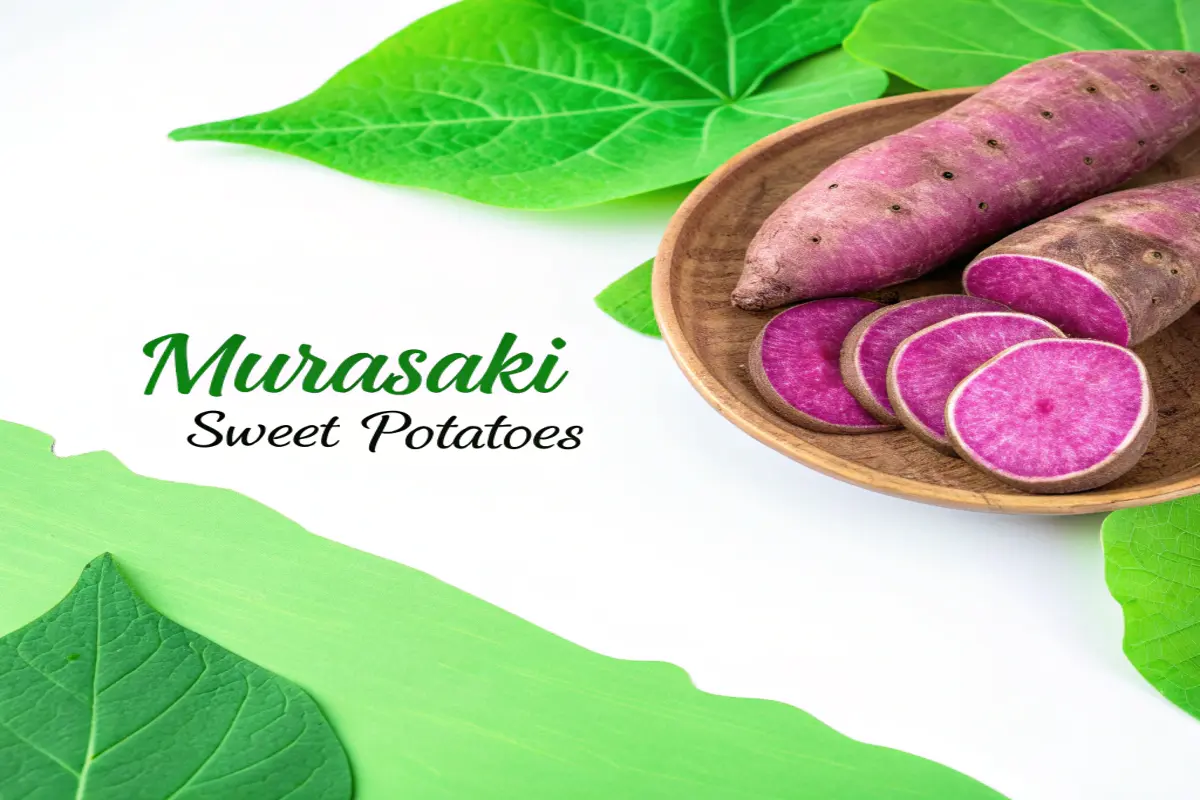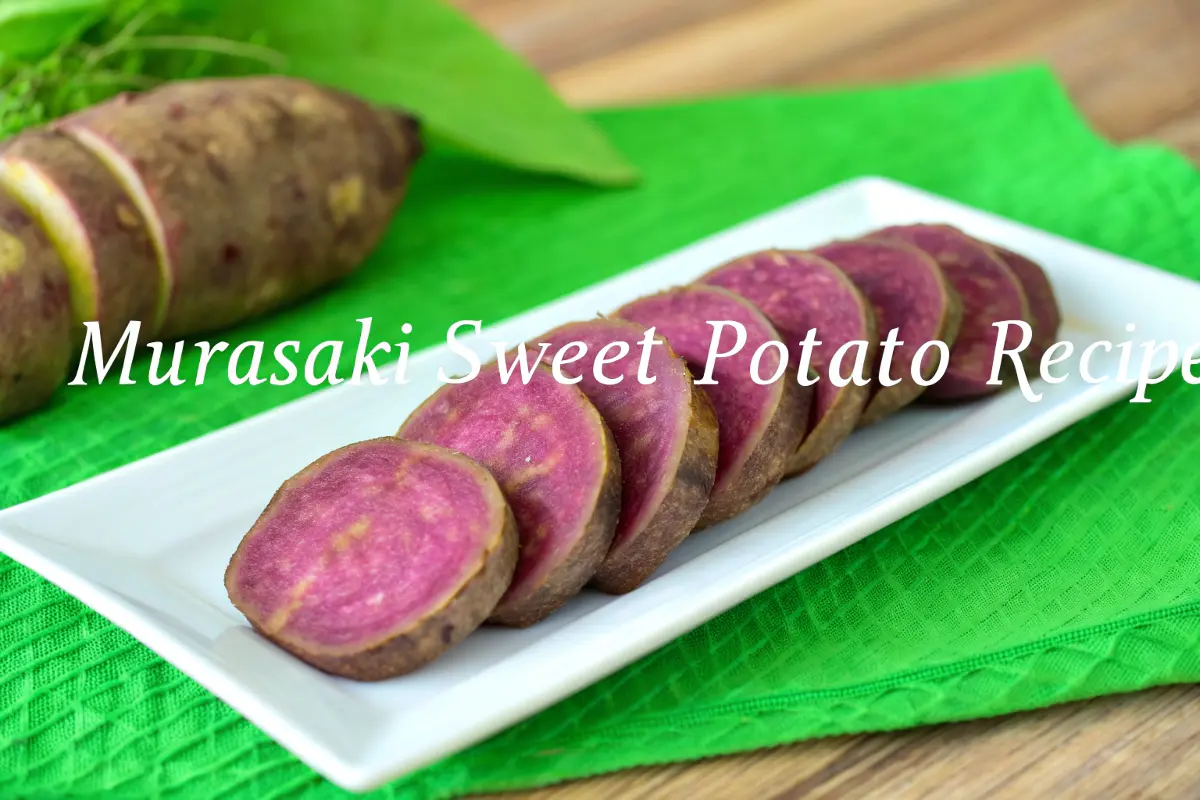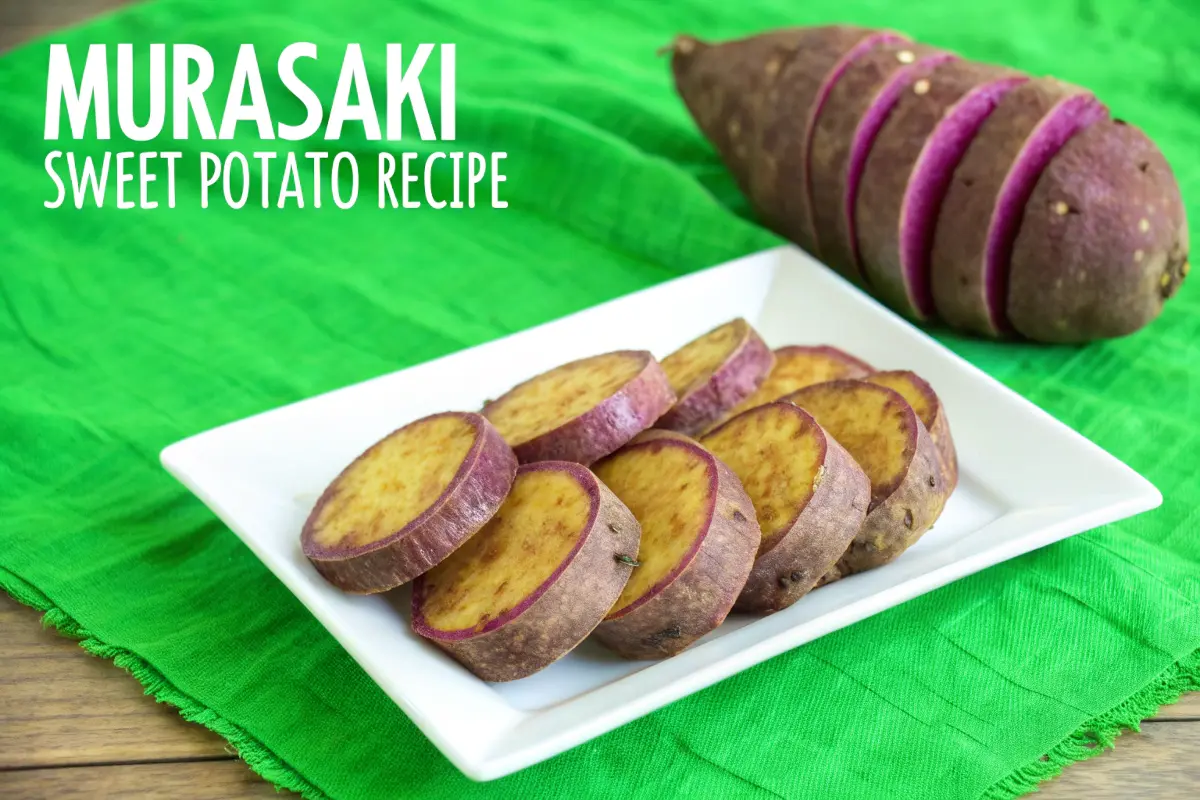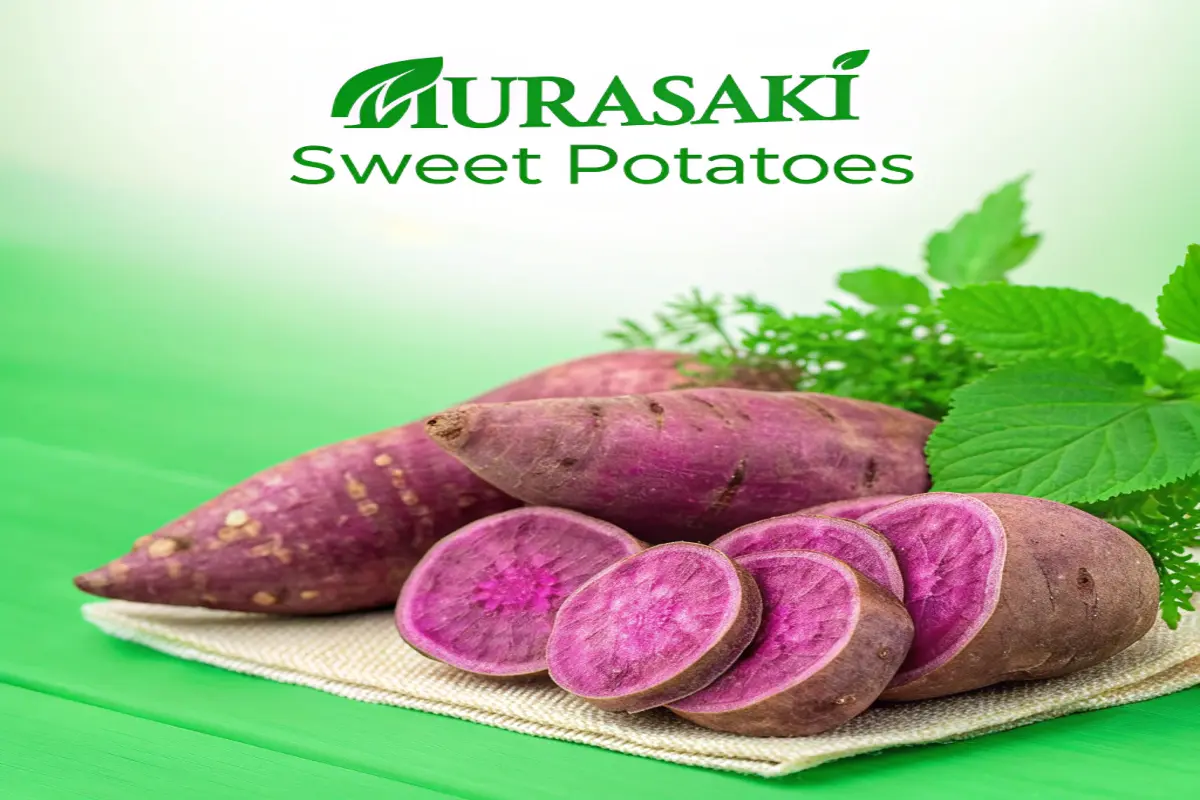Murasaki sweet potatoe, also known as Japanese sweet potatoes, is gaining popularity across the globe due to its unique flavor, nutritional benefits, and versatile culinary uses. This purple-skinned tuber with creamy white flesh is a delightful addition to any meal. Whether you’re a health-conscious foodie or someone exploring new ingredients, understanding it will help you appreciate their potential.
What is Murasaki Sweet Potatoe?
It originate from Japan but is now widely cultivated in the United States, especially in California and Louisiana. This sweet potatoe is distinguishable by their:
- Dark purple skin: A signature feature that sets them apart from other sweet potatoes.
- Creamy white interior: Despite their vibrant skin, the flesh inside is pale and creamy.
- Nutty flavor profile: Unlike traditional sweet potatoes, Murasaki sweet potatoes have a mild, nutty taste with a hint of chestnut.
Why Are They Special?
The combination of their striking appearance and delicate flavor makes them a favorite for both chefs and home cooks. They are especially known for their:
- Low moisture content: Ideal for frying or roasting.
- High starch level: Contributing to their creamy texture when cooked.
- Rich nutritional profile: Loaded with fiber, vitamins, and antioxidants.
Nutritional Benefits
When it comes to health benefits, Murasaki sweet potatoe packs a punch. They are not just delicious but also incredibly nourishing. Below are the key nutrients that make it a superfood:
Rich in Dietary Fiber
- Promotes healthy digestion.
- Helps maintain blood sugar levels.
- Supports weight management by keeping you full for longer.
Packed with Antioxidants
- The purple skin is rich in anthocyanins, which combat free radicals in the body.
- Antioxidants reduce inflammation and lower the risk of chronic diseases.
High in Vitamins and Minerals
- Vitamin A: Boosts eye health and immunity.
- Vitamin C: Aids in collagen production for healthy skin.
- Potassium: Supports heart health by regulating blood pressure.
Low in Calories and Fat
- A single serving of Murasaki sweet potatoes is low in calories, making it a great choice for weight-conscious individuals.
Culinary Uses
One of the most exciting things about them is their versatility. Whether you prefer savory dishes or sweet treats, these tubers can elevate any recipe. Here are some popular ways to use them in the kitchen:
Roasting
Roasted Murasaki sweet potatoe is a simple yet delicious side dish. The high starch content gives it a crispy exterior and a creamy inside.
Pro tip: Toss slices in olive oil, sprinkle with sea salt, and bake at 400°F until golden brown.
Frying
Their firm texture makes them perfect for fries. Thinly slice, fry in your favorite oil, and serve with a sprinkle of paprika for a savory twist.
Baking
Use them in pies, cakes, or muffins for a subtle sweetness. Their creamy flesh blends perfectly into batters.
Steaming or Boiling
Steamed or boiled Murasaki sweet potatoe make a quick and nutritious snack. Add a drizzle of honey or a pinch of cinnamon for a natural dessert.
Soups and Curries
Their mild flavor pairs beautifully with spices, making them an excellent addition to creamy soups and hearty curries.
How to Choose and Store Murasaki Sweet Potatoe

When buying them, follow these tips to select the best ones and store them properly:
Choosing the Right Sweet Potatoes
- Look for potatoes with smooth, unblemished skin.
- Avoid any with cracks, bruises, or soft spots.
- Choose medium-sized tubers for even cooking.
Proper Storage Tips
- Store in a cool, dark place with good ventilation.
- Avoid refrigerating them as it can alter their texture and flavor.
- Keep them away from moisture to prevent spoilage.
Murasaki sweet potatoes can last up to two weeks when stored correctly, making them a great pantry staple.
Growing Your Own Murasaki Potatoe
If you’re a gardening enthusiast, growing them can be a rewarding experience. These steps will help you cultivate them in your backyard:
1. Choose Quality Slips
Start with high-quality slips (sprouted plants) from a reliable source. Look for healthy, green sprouts.
2. Prepare the Soil
- Ensure the soil is well-draining and slightly sandy.
- Sweet potatoes thrive in warm climates with plenty of sunlight.
3. Plant and Water
- Plant the slips 12 inches apart in rows.
- Water regularly but avoid overwatering to prevent root rot.
4. Harvesting
- Harvest after 90–120 days, once the leaves turn yellow.
- Cure the sweet potatoes in a warm, humid space for a week to enhance their sweetness.
Fun Facts
Here are some fascinating facts about Murasaki sweet potatoes that will make you appreciate them even more:
- Despite their Japanese name, most Murasaki sweet potatoes in stores are grown in the U.S.
- They were specifically bred to resist pests and thrive in different climates.
- Their purple skin contains powerful phytochemicals with anti-inflammatory properties.
Exploring the Many Aspects of Murasaki Sweet Potatoes
In this section, we will dive deeper into the cultural significance, advanced culinary techniques, and their unique health benefits. This knowledge will help you understand why these tubers are more than just a trendy food item—they’re a powerhouse ingredient with a rich history.
The Cultural Significance of Murasaki Sweet Potatoes
They are deeply rooted in the culinary traditions of Japan and East Asia. While their cultivation has expanded globally, they hold a special place in Japanese cuisine and culture.
A Historical Staple
- Originally, sweet potatoes were introduced to Japan from China in the 17th century. Over time, various cultivars, including the Murasaki sweet potato, were developed to suit local tastes and climates.
- These sweet potatoes were historically valued as a reliable crop during periods of famine due to their resilience and nutritional content.
Modern-Day Popularity in Japan
In Japan, they are commonly enjoyed as part of daily meals and festive occasions. Some popular uses include:
- Yakiimo: Roasted sweet potatoes sold by street vendors, especially during winter.
- Desserts: Used in traditional sweets like daigaku imo (candied sweet potatoes) or blended into custards and ice creams.
- Tempura: Lightly battered and fried slices that are served with dipping sauces.
A Global Phenomenon
Thanks to their unique flavor and health benefits, Murasaki sweet potatoes have gained international recognition. They’re often featured in modern recipes that blend Japanese traditions with Western cooking techniques, such as sweet potato gnocchi or sushi rolls with roasted sweet potato filling.
Advanced Culinary Techniques for Murasaki Sweet Potatoes
If you’re looking to take your culinary skills to the next level, these advanced techniques will help you unlock the full potential of Murasaki sweet potatoes. Their creamy texture and nutty flavor provide endless opportunities for creativity in the kitchen.
Caramelizing for Maximum Flavor
Caramelizing brings out the natural sugars in Murasaki sweet potatoes, enhancing their sweet and nutty notes.
How to do it:
- Slice the sweet potatoes into even wedges.
- Coat with a light layer of olive oil and sprinkle with a mix of brown sugar and cinnamon.
- Roast at 425°F for 30–35 minutes, flipping halfway through, until golden and caramelized.
Using Them in Fermented Dishes
Fermentation can elevate the flavor of Murasaki sweet potatoes by adding tangy complexity.
Example Recipe: Sweet Potato Kimchi
- Dice the sweet potatoes into small cubes.
- Mix with traditional kimchi ingredients like napa cabbage, garlic, ginger, and chili flakes.
- Allow the mixture to ferment for 1–2 weeks in a cool, dark place.
Pairing with Unexpected Ingredients
They work surprisingly well with ingredients like:
- Cheeses: Such as goat cheese or gruyère for a savory twist.
- Herbs: Like rosemary, thyme, or sage to complement their earthy flavor.
- Spices: Including cumin, paprika, and nutmeg to add warmth.
Innovative Recipe Ideas for Murasaki Sweet Potatoes

Here are some unique and delicious recipes to inspire your next meal:
Murasaki Sweet Potato Buddha Bowl
Create a nourishing Buddha bowl packed with vibrant flavors and textures:
- Base: Quinoa or brown rice.
- Toppings: Roasted Murasaki sweet potatoes, steamed broccoli, avocado slices, and chickpeas.
- Dressing: A tahini-lemon dressing for a zesty finish.
Purple-Skinned Sweet Potato Tart
Turn Murasaki sweet potatoes into an elegant dessert:
- Make a crust with almond flour, butter, and a touch of sugar.
- Blend steamed sweet potatoes with coconut milk, honey, and vanilla to create the filling.
- Bake until set and garnish with whipped cream and toasted nuts.
Sweet Potato Sushi Rolls
Swap traditional sushi fillings for roasted sweet potatoes:
- Roast Murasaki sweet potato strips until tender.
- Roll them with sushi rice, nori, and cucumber slices.
- Serve with soy sauce and pickled ginger.
Health Benefits in Depth
While we’ve touched on the general nutritional profile of Murasaki sweet potatoes, let’s explore their specific health benefits in greater detail.
Gut Health
they are an excellent source of prebiotic fiber, which supports a healthy gut microbiome. A balanced microbiome can:
- Improve digestion.
- Enhance immunity.
- Reduce the risk of conditions like IBS (Irritable Bowel Syndrome).
Blood Sugar Control
Unlike regular potatoes, Murasaki sweet potatoes have a lower glycemic index. This means they cause a slower, steadier rise in blood sugar levels, making them a great option for people with diabetes or anyone managing blood sugar levels.
Brain Health
The antioxidants in Murasaki sweet potatoes, especially anthocyanins, have been shown to:
- Protect against cognitive decline.
- Improve memory and learning.
- Combat oxidative stress in brain cells.
Cancer-Fighting Properties
Studies suggest that the compounds in purple-skinned vegetables, such as Murasaki sweet potatoes, may have anti-cancer properties. Anthocyanins, in particular, have shown potential in reducing the growth of certain cancer cells.
Tips for Maximizing Health Benefits
To retain the maximum nutritional value of Murasaki sweet potatoes, follow these tips:
- Cook with the skin on: The skin contains the majority of the antioxidants.
- Avoid overcooking: Boiling or steaming for shorter durations helps preserve vitamins and minerals.
- Pair with healthy fats: Drizzle with olive oil or serve with avocado to enhance the absorption of fat-soluble nutrients like Vitamin A.
Popular Substitutes for Murasaki Sweet Potatoes
While they are unique, there are substitutes if they’re unavailable:
- Hannah Sweet Potatoes: These have a similar creamy texture and nutty flavor.
- Purple Yams (Ube): Slightly sweeter and more vibrant in color.
- Standard Orange Sweet Potatoes: A common substitute with a sweeter taste and higher moisture content.
They are a versatile, nutritious, and culturally rich ingredient that deserves a place in your kitchen. From roasting and fermenting to innovative pairings and health benefits, they offer endless opportunities for creativity and wellness.
Deep Dive into Murasaki Sweet Potatoes – Sustainability, Storage, and Global Demand
In this final section, we’ll explore the broader their context—their role in sustainable agriculture, tips for extending their shelf life, and how their growing demand is shaping food trends globally. By the end, you’ll have a complete understanding of why they are more than just a culinary gem.
The Role of them in Sustainable Agriculture
In an era where environmental sustainability is a top priority, Murasaki sweet potatoes offer a range of benefits to farmers and the planet. Their cultivation methods, pest resistance, and adaptability make them a smart choice for eco-conscious food production.
1. Efficient Water Use
Murasaki sweet potatoes are naturally drought-tolerant. Their deep root systems allow them to access water from lower soil layers, requiring less irrigation compared to other crops. This makes them ideal for regions prone to water scarcity.
Environmental benefit: Reduced water usage supports sustainable farming practices and conserves vital water resources.
2. Pest Resistance
These sweet potatoes were specifically bred for their ability to resist common pests, such as root-knot nematodes. This reduces the need for chemical pesticides, which can harm the environment and contaminate nearby water sources.
Environmental benefit:
Lower reliance on pesticides contributes to cleaner ecosystems and healthier soil.
3. Soil Health
Sweet potato plants are excellent at preventing soil erosion due to their sprawling vines and robust roots. They also improve soil fertility by adding organic matter when decomposed after harvest.
Environmental benefit: Healthier soil ensures long-term productivity and reduces the need for synthetic fertilizers.
Storage Hacks to Keep Murasaki Sweet Potatoes Fresh

To enjoy the unique flavor and texture of Murasaki sweet potatoes, proper storage is essential. Follow these practical tips to extend their shelf life while maintaining their quality.
1. Choose the Right Conditions
Murasaki sweet potatoes thrive in environments with:
- A cool temperature of 55–60°F.
- Low humidity to prevent mold.
- Good ventilation to avoid moisture buildup.
Avoid storing them in refrigerators, as cold temperatures can cause their starches to convert to sugar, altering their taste and texture.
2. Use a Breathable Storage Container
Place the sweet potatoes in a basket, mesh bag, or perforated cardboard box to ensure air circulation. This prevents moisture from accumulating and causing rot.
3. Check Regularly for Spoilage
Inspect your sweet potatoes weekly for signs of:
- Soft spots: Indicating spoilage.
- Wrinkles or shriveling: A sign of dehydration.
- Sprouts: These don’t affect edibility but indicate that they should be used soon.
Addressing Global Demand for them
In recent years, its popularity has skyrocketed, thanks to their unique flavor, aesthetic appeal, and health benefits. Let’s explore how this demand is shaping global agriculture and culinary trends.
1. The Superfood Trend
As consumers prioritize health-conscious diets, Murasaki sweet potatoes have emerged as a sought-after superfood. Their high levels of antioxidants, vitamins, and fiber align perfectly with wellness-focused eating habits.
Impact: Restaurants and food brands are incorporating Murasaki sweet potatoes into menus and products, including chips, frozen meals, and even baby food.
2. Export and Availability
While the majority of them are grown in the U.S., their export to countries like Canada, Australia, and the U.K. has increased. However, the high demand occasionally leads to supply shortages.
Impact: Farmers are expanding cultivation areas to meet global demand, making Murasaki sweet potatoes more accessible to consumers worldwide.
3. Culinary Creativity
Chefs and home cooks alike are experimenting with them in innovative recipes. Their visual appeal (purple skin and creamy interior) makes them Instagram-worthy, further fueling their popularity.
Examples: Sweet potato lattes, fusion desserts, and artistic food plating featuring these vibrant tubers.
Unique Ways to Incorporate Murasaki Sweet Potatoes in Your Diet
Beyond traditional recipes, here are some unconventional ways to enjoy them:
1. Sweet Potato Smoothies
Blend roasted sweet potato chunks with almond milk, banana, and a pinch of cinnamon for a nutrient-packed breakfast or post-workout snack.
2. Sweet Potato Bread
Substitute mashed Murasaki sweet potatoes for bananas in banana bread recipes. The result? A moist, subtly sweet loaf with a beautiful golden hue.
3. Savory Mash with a Twist
Combine mashed sweet potatoes with caramelized onions, roasted garlic, and a dash of smoked paprika for a savory side dish.
Challenges in Cultivating Murasaki Sweet Potatoes
While they offer numerous benefits, their cultivation is not without challenges. Farmers must overcome the following obstacles to ensure consistent yields:
1. Climate Sensitivity
Although drought-tolerant, Murasaki sweet potatoes require warm temperatures for optimal growth. Prolonged exposure to cold weather can stunt their development.
Solution: Farmers often grow them in regions with mild winters or use greenhouses to extend the growing season.
2. Labor-Intensive Harvesting
Harvesting sweet potatoes is a time-consuming process that requires careful handling to avoid damaging the delicate tubers.
Solution: Innovative farming equipment is being developed to streamline the harvesting process.
FAQs
1. What is the difference between sweet potatoes and Murasaki sweet potatoe?
Regular sweet potatoe usually has orange flesh and a moist texture, while Murasaki sweet potatoes have purple skin, white flesh, and a drier, nutty flavor.
2. Are Murasaki sweet potatoes healthier?
They are rich in antioxidants, fiber, and vitamins, but their overall health benefits are similar to other sweet potatoes.
3. Which is the healthiest sweet potato?
Purple sweet potatoes, including Murasaki, are considered the healthiest due to their high levels of antioxidants.
4. How do you eat Murasaki sweet potatoes?
They can be baked, roasted, steamed, or mashed, and are delicious as a side dish or snack.
5. Can you eat Japanese sweet potatoe every day?
Yes, you can eat them daily in moderation, as they are nutrient-dense and low in fat, but balance them with other foods for variety.
6. How much protein is in a Murasaki sweet potato?
A medium one contains about 2 grams of protein.
7. Is Japanese sweet potato a superfood?
Yes, it is often considered a superfood due to its high fiber, antioxidants, and essential nutrients.
8. Which is healthier: sweet potato or Japanese sweet potato?
Both are healthy, but Japanese sweet potatoes may have more antioxidants and a lower glycemic index.
9. Is sweet potato high in carbs or protein?
They are high in carbs and relatively low in protein.
Conclusion
Murasaki sweet potatoe isn’t just another ingredient—they’re a gateway to creating healthier, tastier, and visually stunning meals. Whether you’re crafting a savory dinner masterpiece or indulging in a sweet treat, their unique flavor, nutritional power, and versatility make them an absolute must-have in your kitchen.
If you’re looking for inspiration, check out our healthy dinner recipes or explore our guide on nutrient-rich superfoods to pair with your Murasaki sweet potatoes. For sweet options, our dessert recipes featuring unique ingredients might spark your creativity.
Don’t wait to explore the magic of Murasaki sweet potatoes! Add them to your next meal and experience their incredible taste and health benefits for yourself.
What will you make with Murasaki sweet potatoes?
Share your ideas or try one of the recipes above, and let us know how you’ve used this superfood to transform your meals!

